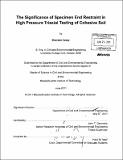The significance of specimen end restraint in high pressure triaxial testing of cohesive soil
Author(s)
Casey, Brendan (Brendan Anthony)
DownloadFull printable version (19.07Mb)
Other Contributors
Massachusetts Institute of Technology. Dept. of Civil and Environmental Engineering.
Advisor
John T. Germaine.
Terms of use
Metadata
Show full item recordAbstract
This thesis investigates the mechanical behaviour of cohesive soil at relatively high stresses with a particular emphasis on the significance of specimen end restraint on the interpretation of triaxial test results. Undrained triaxial shear tests have been performed on specimens K0 consolidated to stresses ranging from 0.6 to 10 MPa. Behaviour is examined at three well-defined OCRs of 1, 2 and 4 in compression mode of shear. The tests were performed on Resedimented Boston Blue Clay (RBBC), a low plasticity illitic clay resedimented in the laboratory from natural Boston Blue Clay. The triaxial test results demonstrate a significant and consistent decrease in normalized undrained strength, initial stiffness and friction angle with increasing stress level at each OCR. These trends are observed regardless of specimen end condition and are consistent with the results of previous studies performed on RBBC as well as on other resedimented clays. Previous investigations which have examined behaviour at high stresses through a program of laboratory triaxial testing have all involved the use of fixed ends in the triaxial device, i.e. the ends of the specimen are restrained from radial deformation by rough porous stones. Problems associated with specimen end restraint can be minimized by using smooth end platens in the triaxial device. The impact of end restraint has been examined by comparing the results of triaxial tests performed using smooth ends with corresponding results obtained using conventional fixed ends. When shearing is carried out at a relatively slow rate, the use of fixed ends has been shown to result in a small but consistent underestimation of undrained strength at each OCR tested. In addition, the use of fixed ends results in the measurement of misleadingly high pore pressures during undrained shearing, even when shearing is performed at a slow rate and pore pressure equalization is allowed to occur throughout a specimen. Slip surfaces were not found to develop during shearing for tests performed with smooth ends, although they do occur if fixed ends are used. The occurrence of a slip surface in resedimented clay is believed to be caused by the boundary conditions of the test.
Description
Thesis (S.M.)--Massachusetts Institute of Technology, Dept. of Civil and Environmental Engineering, 2011. Cataloged from PDF version of thesis. Includes bibliographical references (p. 170-175).
Date issued
2011Department
Massachusetts Institute of Technology. Department of Civil and Environmental EngineeringPublisher
Massachusetts Institute of Technology
Keywords
Civil and Environmental Engineering.